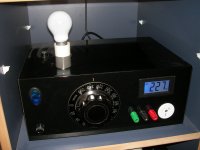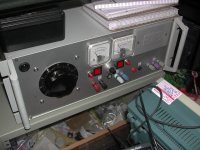How many amps are necessary for trouble-shooting a tube set-up such as a fisher or sherwood amp? 10, 15, 20, more?
with 10 or 20 amps you can arc weld...
Bigger is always better, but its generally more expensive too. A 500W variac should be ample, 350W would be ok. Less than that is likely a toy.
Bigger is always better, but its generally more expensive too. A 500W variac should be ample, 350W would be ok. Less than that is likely a toy.
+1 on Aardvark's advice.
OT: I've got variac(s) but seldom use 'em for troubleshooting.
I find that the 'dim bulb tester' is more useful (and protects the 'test subject' better, too).
OT: I've got variac(s) but seldom use 'em for troubleshooting.
I find that the 'dim bulb tester' is more useful (and protects the 'test subject' better, too).
Hi John
Not sure on the rating of mine (about an amp) but it works fine
I agree with VictoriaGuy but have my Variac setup with a filament lamp in series. Almost covers all bases, just need to add a ammeter.
Cheers
Not sure on the rating of mine (about an amp) but it works fine
I agree with VictoriaGuy but have my Variac setup with a filament lamp in series. Almost covers all bases, just need to add a ammeter.
Cheers
I use the variac in my shop all the time, an ammeter takes the place of a bulb. Either method works.
The variac is used mainly when things are wanting to bow fuses, I don't need it to be able to power the unit under test to its full output. Once we have established that the amp is stable and ready for high power testing, I no longer need what the variac does, and I power the UUT from the wall.
All that is the long way to say that I don;t ned a 1000 watt variac to service 1000 watt amplifiers. A smaller one will still be useful.
The variac is used mainly when things are wanting to bow fuses, I don't need it to be able to power the unit under test to its full output. Once we have established that the amp is stable and ready for high power testing, I no longer need what the variac does, and I power the UUT from the wall.
All that is the long way to say that I don;t ned a 1000 watt variac to service 1000 watt amplifiers. A smaller one will still be useful.
I always wanted to make a variac test box that had meters for voltage and current and also switches to put in a 100 or 25 watt lamp. Maybe add a receptacle and also binding posts...
I tried using a 2A variac once, and proceeded to blow the windings.
Best to use an over-rated one in case something shorts out.
Best to use an over-rated one in case something shorts out.
Certainly true in your hands, but for anyone 'starting out' the bulb does have the 'current limiting' feature that the ammeter lacks. Most days, I need my stuff to be idiot-proof, as much as possible.I use the variac in my shop all the time, an ammeter takes the place of a bulb. Either method works.
Now, (belt, suspenders, and piece of rope dept) Variac, voltmeter, bulbs, and ammeter: SWEET!
Oh, yeah- don't forget to protect the Variac with its own (correct rating) fuse...
I tried using a 2A variac once, and proceeded to blow the windings.
Best to use an over-rated one in case something shorts out.
Happened to me one time as well with a small variac. While taking some readings from an unknown transformer the 6v winding leads touched and spot welded themselves together. Before I could pull the plug a variac winding heated up and melted. It was right at the very start so soldering a new piece of wire was easy.
Dagwood: Yep thats about what I was thinking, except maybe having the lamps inside with a small hole to see the brightness.
I think my big variac is 20A. I have five or six I guess. If they are free, I'll take them every time.
My experience with my Sherwood 8000 (RIP) was that I constantly fiddled with ever-better sound. What I am thinking is that the variac (or other auto transformer) would be hooked up full time in case lowering (or impeding) AC input happens to improve the sound.
On that note, the last thing I did to the Sherwood was to cross-over point two small Jamo satellite speakers at the Yamaha Natural main speakers, which really brought things to life. Then it started making too much noise, I took it apart, found a mouse nest, and ultimately found that tapping a rectangular resistor caused the sound to change and then die completely and then come back, but that sound was distinctly different from the other noises so I figure there is a lot wrong with it. BTW, it's true about the voltages; when I was tapping around, my finger slipped and whammo, woke right up, and my finger felt like it had a vice grip on it!
So I am attempting to retrench with knowledge, which is taking a lot of imagination. Frankly, I am not sure any single (living) person actually knows how these things work in their full glory.
My project page: Wikiversity::HiFi
On that note, the last thing I did to the Sherwood was to cross-over point two small Jamo satellite speakers at the Yamaha Natural main speakers, which really brought things to life. Then it started making too much noise, I took it apart, found a mouse nest, and ultimately found that tapping a rectangular resistor caused the sound to change and then die completely and then come back, but that sound was distinctly different from the other noises so I figure there is a lot wrong with it. BTW, it's true about the voltages; when I was tapping around, my finger slipped and whammo, woke right up, and my finger felt like it had a vice grip on it!
So I am attempting to retrench with knowledge, which is taking a lot of imagination. Frankly, I am not sure any single (living) person actually knows how these things work in their full glory.
My project page: Wikiversity::HiFi
Last edited:
I always wanted to make a variac test box that had meters for voltage and current and also switches to put in a 100 or 25 watt lamp. Maybe add a receptacle and also binding posts...
or this......
No lamp, but it also has variable B+ (by using the variac on the primary side of the PS transformer), variable bias voltage and 6V/12V heater binding posts.....The variac also controls the mains voltage at the receptacle.
Attachments
If the variac is melting under fault currents, where is the fuse?
Obviously one can go way too small on one and have it fail.
Obviously one can go way too small on one and have it fail.
- Status
- Not open for further replies.
- Home
- Design & Build
- Parts
- variac variable transformer

